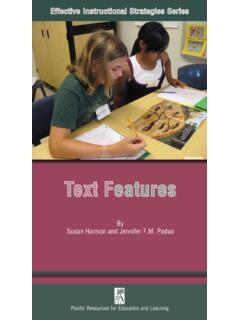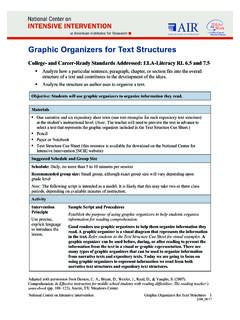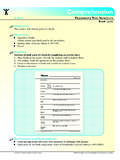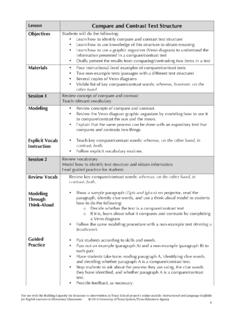Transcription of Text Structure: Cause and Effect - PREL
1 Effective Instructional Strategies SeriesPacific Resources for Education and LearningText structure : Cause and EffectBy Jennifer PaduaEffective Instructional StrategiesAcknowledgmentsSpecial thanks Gerald Duffy for his content review of this Roger J. Chesswas for his vision, support and leadership in directing the Pacific CHILD Randomized Control Advisory Panel Members: Drs. Michael Kamil, Gerald Duffy, Anne Cunningham, Jana Echevarria, and Dorothy Strickland for their guidance during the Pacific CHILD Hanson and Sharon M. Look for their contributions to this Hokama, Karen Pascual, Clyde Sabas, and Mary Silva for their staff members for their hard work and dedication with the Pacific CHILD Pacific CHILD Teachers in American Samoa, the Commonwealth of Northern Mariana Islands, and Hawai i: We appreciate all the learning opportunities and your commitments in helping us gather information on how to improve teacher knowledge and practice, and students reading product was funded by the Department of Education s Institute of Education Sciences (IES) under the Regional Educa tional Laboratory Pacific administered by Pacific Resources for Education and Learning, award number ED-06-CO-0024.
2 The content of the publication does not necessarily reflect the views or policies of IES or the Department of Education nor does mention of trade names, commercial products, or organizations imply endorsement by the Picture: Jennifer PaduaText structure : Cause and Effect1 Text structure : Cause and EffectContentsA Teacher s Story ..2 What is Text structure ? ..5 Why is Learning Text structure Important? ..5 Two Key Steps to Teach Cause and Effect ..6 Three Strategies to Teach Cause and Effect ..7 Connecting Text structure Learning from Reading to Writing ..13 Overview of Key Steps ..16 References ..172 Effective Instructional StrategiesA Teacher s StoryMrs. Kealoha is getting ready to start her thematic unit on the American Revolution.
3 Her mind wanders: there is so much to teach in a short amount of time; the students struggle with knowing this era of America s history; the content is challenging, especially when students need to understand that authors structure text in different ways. Where do I begin? Mrs. Kealoha realizes that in order for her 5th grade students to under-stand the text structure , she must review her lesson on how authors use different types of text structures. She knows her students understand the concept of Cause and Effect , but she is unsure if they are able to identify it in writing. Not an easy task, she begins searching for a short paragraph to use for the next day s lesson. Mrs. Kealoha wants this initial lesson to make an impact.
4 She knows her students learned about Cause and Effect in science and wants to transfer this knowledge to the social studies next day, Mrs. Kealoha feels confident that this lesson will be more effective. She knows the importance of tapping into students background knowledge, and chose a passage that students can relate to. She passes out the following paragraph and asks her students to read it. On September 11, 1992, Hurricane Iniki struck the Hawaiian Islands. It was the most powerful hurricane to hit the Hawaiian Islands. As a result, Hurricane Iniki caused billion dollars in damages and six people died. The island of Kaua i suffered the most damage. More than 1,400 homes were destroyed and thou-sands more were damaged.
5 The heavy winds and rains caused many farmers to lose their crops. For weeks, residents of Kaua i did not have electricity. Good Morning boys and girls. Today, we will continue to learn about the American Revolution. Lei raises her hand. Mrs. Kealoha, if we re studying about the American Revolution, why are we reading about hurricanes?Mrs. Kealoha grins. We will learn about the American Revolution, but before we begin, let s talk about text structure . Text structure refers to how authors structure or organize their writing in different ways. Text structure : Cause and Effect3 Tyler raises his hand. Is this like when we read books to see how the authors compared and contrasted different topics?
6 Mrs. Kealoha replies. Yes, exactly. Today we will learn about the text structure of Cause and Effect . But first, I want to see if you understand the concept of Cause and Effect . The relationship of Cause and Effect is to understand what happened and why it hap-pened. When we want to know what happened, this is called the Effect . When we want to know the reasons why an event or events happened, this is called the Cause . So who can tell me the Effect or what happened when Hurricane Iniki struck the Hawaiian Islands? Students hands spring up .. more than 1,400 houses were destroyed; farmers lost their crops; people lived without electricity. Who can tell me the Cause or why houses were destroyed or farm-ers lost their crops?
7 Hurricane Iniki, the students shout. Mrs. Kealoha feels great about the day s lesson. Students were able to identify the Cause and Effect in the text. She knows they are familiar with this topic, and is confident that if she continues the question-ing and dissecting of text, the students will be able to understand the American Revolution. 4 Effective Instructional StrategiesAs students progress through schooling, the content that is learned is often factual. For many students, they have too few experiences and/or lack the background knowledge about various factual information, which often hinders their ability to comprehend content area subjects. In this book, Effective Instructional Strategies: Cause and Effect , you will learn the importance of teaching Cause and Effect through one teacher s journey.
8 The goal is for you to learn the research supporting these key practices and how you can take these examples and apply them in the classroom with your students. All persons referred to are fictional framework for this book is the Pacific Communities with High-performance In Literacy Development (Pacific CHILD) Teachers Manual. Pacific CHILD is a professional development program that was tested in the Pacific region using a true randomized control trial design. The Pacific CHILD is a principles-based professional develop-ment program consisting of research-based teaching and learning strat-egies proven to help improve students reading comprehension using informational by Jennifer PaduaText structure : Cause and Effect5 What is Text structure ?
9 Text structure is the way authors organize their writing. Each structure has distinctive characteristics that help the reader understand what writing genre is being used. In informational text and content area text books, the most commonly used text struc-tures are Cause and Effect , compare and contrast, and description and classification (Pacific Resources for Education and Learning, 2008). Why is Learning Text structure Important? In upper elementary grades and higher, students are faced with read-ing more content area texts . Content area texts are organized in dif-ferent ways, and knowing those ways helps students get the mean-ing. The writing in these texts can be abstract and/or contain too many unknown academic words, making it difficult for the reader to under-stand.
10 The topics may also be unfamiliar to the reader. The teaching of text structure is important for many reasons. Students comprehension is improved when they understand the text features (the physical presentation of the text) and the text structure (the way authors structure or organize their writ-ing) (Dickson, Simmons, and Kame enui, 1995). When readers can anticipate where information is located in the text, they are able to make predictions about the content and will better understand what the author is trying to explain (Dymock, 2007; Meyer & Poon, 2001; Duke & Pearson, 2002). If readers become confused by what they are reading, they can use what they know about text structure as a strategy to help them figure out the meaning and clear up their confusion (Tovani, 2000).









